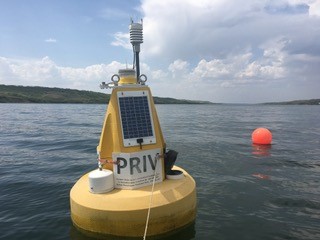A partnership between a University of Saskatchewan (USask) researcher and the Buffalo Pound Water Treatment Plant will bring “cutting-edge monitoring equipment” to the province.

A joint press release said the equipment will advance lake science as well as safeguard drinking water for 260,000 people.
Buffalo Pound Water Treatment Plant is owned by the cities of Regina and Moose Jaw and supplies drinking water to residents.
The independent board of directors as well as plant president and CEO Ryan Johnson have approved the purchase of a custom-designed $250,000 high-tech buoy that’s been nicknamed “Superbuoy”.
The new buoy is expected to arrive in time for the 2022 summer season.
Blair Kardash, laboratory and research manager at the plant said the new buoy will replace one that has been in place for seven years and is owned by USask researcher Helen Baulch.
“Over the last seven years, we’ve learned its advantages of real-time water-quality monitoring and it is part of operations now and we don’t want to be without it,” Kardash told Global News.
According to the release, the superbuoy has research-grade weather and atmosphere monitors, as well as an array of winter-hardy water quality sensors for year-round use.
- Ontario takes action against chemical plant after Aamjiwnaang First Nation residents fell ill
- High benzene levels detected near Ontario First Nation for weeks, residents report sickness
- Beijing orders Apple to pull WhatsApp, Threads from its China app store
- Fishing vessel with crane, net arrives in Zeballos for orca calf rescue
Baulch said the superbuoy provides continuity from a research perspective, along with some “neat new tools.”
“For example, it has cutting-edge sensors to more accurately measure carbon dioxide that’s important to lake ecology, and some new cameras with telemetry so that we are able to monitor the lake surface for scum, from our desks in Saskatoon and get down there to sample it.”
The new buoy will arrive at a time when huge algal blooms can occur on Buffalo Pound Lake.
“(A)nd when rapid changes to conditions, such as large temperature variations between upper and lower lake levels, sometimes cause major problems for the plant that supplies potable water to Regina, Moose Jaw and nearby areas,” the release added.
Baulch explained that climate change combined with changes to land use are putting unprecedented pressure on aquatic systems in the Prairies and increasing the risks of harmful cyanobacterial (blue green algae) blooms.
“Because Buffalo Pound Lake is so shallow, things like algae growth and water temperature change pretty quickly. The plant operators have seen those changes affect their operations, and our research collaboration has really helped troubleshoot and anticipate some of those changes,” Baulch said.
Kardash described the partnership between the treatment plant and USask team as an academic and industrial cooperation that has been very successful.
“As a result, our corporation is investing some money to facilitate and continue Dr. Baulch’s research, because again, long-term water quality is an issue that is very important to the water treatment plant,” Kardash said.
Kardash pointed to an example in May 2015 that saw the plant go to a maximum of 50-per cent capacity for about two weeks.
“It was using temperature data from that buoy that allowed us to understand the root cause of why that occurred — that had never occurred in the plant before, something that severe,” Kardash said.
Kardash said the situation was caused by temperature variations of very warm days and very cold nights, resulting in one area of the treatment process going under a condition known as short-circuiting.
He explained the buoy is an invaluable tool with alerting software that notifies operators in real time about certain conditions that may cause upsets, giving operators time to prepare.
Kardash said the new buoy is currently under construction and is expected to arrive in April. It will last between five to seven years before needing to be replaced.
Baulch’s research budget will cover the maintenance of the buoy for the duration of its lifetime, and the treatment plant will provide in-kind contributions, Kardash explained.






Comments